Caryn
 The moonless night was dark, quiet, and peaceful. The children were tucked in their beds in the trailer, while their parents, my sister, Alena Stevens and her husband, Mike sat outside by the campfire. It had been a beautiful day on vacation. They love camping, and this was the perfect ending to a perfect day. After sitting by the campfire for a while, they decided that it was time to go to bed. They tip toed into the trailer, where the candle in the sink that Alena had left burning for a night light for the kids had burned itself out, leaving the trailer very dark. They climbed into bed, and started to drift off to sleep. Suddenly the quiet was shattered as their ten year old son, Garrett sat up and yelled, “I’m blind!!” To which my sister said, “No you’re not. It’s just dark. Go back to sleep.” I’m sure it was all she could do to hold back the giggles that were bubbling up inside her. I know it would be hard for me.
The moonless night was dark, quiet, and peaceful. The children were tucked in their beds in the trailer, while their parents, my sister, Alena Stevens and her husband, Mike sat outside by the campfire. It had been a beautiful day on vacation. They love camping, and this was the perfect ending to a perfect day. After sitting by the campfire for a while, they decided that it was time to go to bed. They tip toed into the trailer, where the candle in the sink that Alena had left burning for a night light for the kids had burned itself out, leaving the trailer very dark. They climbed into bed, and started to drift off to sleep. Suddenly the quiet was shattered as their ten year old son, Garrett sat up and yelled, “I’m blind!!” To which my sister said, “No you’re not. It’s just dark. Go back to sleep.” I’m sure it was all she could do to hold back the giggles that were bubbling up inside her. I know it would be hard for me.
This was not the first time Garrett would do some goofy thing, nor would it be the last. When Garrett was about three or four, he decided that he wanted to ride a big boy bicycle, so his parents got him a two wheeler and put training wheels on it. Garrett was floating on air. He loved riding around on the bike. That didn’t mean, 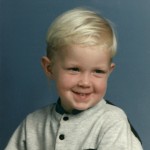 however, that he was in any hurry to get rid of the training wheels, because he wasn’t. Garrett rode around on that bike with training wheels for quite a while…so long, in fact that eventually, one of the training wheels fell off. Even then, Garrett didn’t feel the need to take off the other training wheel. No, he rode around on three wheels until the other training wheel broke off, probably during a leaning turn that only a kid who doesn’t need training wheels can make. And so it was that Garrett learned that he didn’t need training wheels, and probably hadn’t for some time.
however, that he was in any hurry to get rid of the training wheels, because he wasn’t. Garrett rode around on that bike with training wheels for quite a while…so long, in fact that eventually, one of the training wheels fell off. Even then, Garrett didn’t feel the need to take off the other training wheel. No, he rode around on three wheels until the other training wheel broke off, probably during a leaning turn that only a kid who doesn’t need training wheels can make. And so it was that Garrett learned that he didn’t need training wheels, and probably hadn’t for some time.
Not all of Garrett’s antics were on his own, of course. His sisters, Michelle and Lacey got in on some of them too. I’m sure you think you know what to do with a sleeping bag, but you would be wrong. A sleeping bag isn’t just for sleeping. No, it makes a perfect sled too. The three kids used to get on the sleeping bags and slide down the stairs in the classic style of the Home Alone movies. The biggest problem was that unlike the Home Alone movie, where McCauley Calkin used the sled and went right out the front door, their stairs ended with a wall a very short distance away. Nevertheless, the fun continued until one of the kids hit the wall a little too hard and ended up crying. Then Alena had to make them stop.

Those days of being a silly little boy are long gone now, but Garrett is still a joker in any way he can think up. I guess some things will never change…or will they. These days Garrett is busy making plans of a different kind. He is ready to take the next big step in his life, as he and his fiancée, Kayla Smiley plan their wedding to take place some time next summer. Their marriage, however, will probably not change Garrett’s funny side. While Garrett is the kind of man who is always ready to help whenever he is needed, he also still loves to pull pranks and other jokes on people whenever he can. I’m quite sure that they will never have a dull moment in their lives together. Today is Garrett’s birthday. Happy birthday Garrett!! Have a great day!! We love you!!
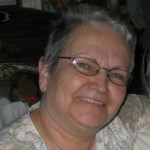
 My cousin, Shirley Cameron lives on the top of a mountain in Washington state. It was a beautiful, rugged, tree filled area, that is quiet and peaceful. She raises chickens and ducks, for their eggs, and gardens in the summer months. She loves to can food, and make jellies and jams of all kinds of unique flavors…and believe me, they are wonderful. In the summer months, there are bears in the area, which I think would bother me a bit, but Shirley is used to it, so she just knows how to stay calm and wait them out. She has lived on this mountain top for many years now, as did her parents before their passing. The place might be a bit wild by city dwellers standards, but for Shirley it is home, and I don’t know if she could really ever see herself living anywhere else now.
My cousin, Shirley Cameron lives on the top of a mountain in Washington state. It was a beautiful, rugged, tree filled area, that is quiet and peaceful. She raises chickens and ducks, for their eggs, and gardens in the summer months. She loves to can food, and make jellies and jams of all kinds of unique flavors…and believe me, they are wonderful. In the summer months, there are bears in the area, which I think would bother me a bit, but Shirley is used to it, so she just knows how to stay calm and wait them out. She has lived on this mountain top for many years now, as did her parents before their passing. The place might be a bit wild by city dwellers standards, but for Shirley it is home, and I don’t know if she could really ever see herself living anywhere else now.
 There was a time, however, when Shirley lived in the very populated areas of Reno, Nevada and Vallejo, California, which is possibly the main reason she lives where she does now. Too many people in one area can drive you crazy, and then the best solution is for find peace in the general solitude of a mountain top. Now don’t get me wrong, Shirley isn’t a recluse. She enjoys being with people, getting online and connecting via Facebook, and even going into town and meeting up with friends, but when she goes home, it is to her beloved mountain. In many ways, I think it is there that Shirley feels the closest to her parents. They loved the mountain top too, and in fact, at one time the whole family lived up there on separate places. It was their little slice of Heaven on Earth. And it is where Shirley still loves to be, because of its quiet, peaceful beauty.
There was a time, however, when Shirley lived in the very populated areas of Reno, Nevada and Vallejo, California, which is possibly the main reason she lives where she does now. Too many people in one area can drive you crazy, and then the best solution is for find peace in the general solitude of a mountain top. Now don’t get me wrong, Shirley isn’t a recluse. She enjoys being with people, getting online and connecting via Facebook, and even going into town and meeting up with friends, but when she goes home, it is to her beloved mountain. In many ways, I think it is there that Shirley feels the closest to her parents. They loved the mountain top too, and in fact, at one time the whole family lived up there on separate places. It was their little slice of Heaven on Earth. And it is where Shirley still loves to be, because of its quiet, peaceful beauty.
Shirley loves to take photographs of the different wildlife in the area. I have deer that come into my yard on occasion, but Shirley sees moose in her yard, and bald eagles in the trees. There are fox, deer, and every other 
 animal imaginable too. I can see why she likes it there…in the summer anyway. And then there are the flowers. Wild flowers are everywhere, of course, but Shirley has a green thumb…unlike her cousin, aka me. She is able to grow not only a vegetable garden, but beautiful flower gardens as well. Her pictures of Iris and Peonies are stunning. While country life is not really what I want anymore, I still think it would be very inspirational to sit a while in her yard. Today is Shirley’s birthday. Happy birthday Shirley!! You are an amazing woman. Have a great day!! We love you!!
animal imaginable too. I can see why she likes it there…in the summer anyway. And then there are the flowers. Wild flowers are everywhere, of course, but Shirley has a green thumb…unlike her cousin, aka me. She is able to grow not only a vegetable garden, but beautiful flower gardens as well. Her pictures of Iris and Peonies are stunning. While country life is not really what I want anymore, I still think it would be very inspirational to sit a while in her yard. Today is Shirley’s birthday. Happy birthday Shirley!! You are an amazing woman. Have a great day!! We love you!!
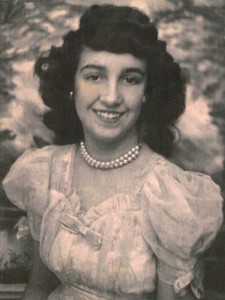 My Aunt Virginia Beadle is a soft spoken, teeny little woman, who is beautiful, inside and out. Beauty is a trait the Byer family kids all had in common, although I’m sure the two boys preferred handsome. Nevertheless, my grandparents did give birth to nine very beautiful people. Aunt Virginia was the second of my grandparents’ children, following my Aunt Evelyn, who was about two years older than Aunt Virginia. Like her older sister, Aunt Virginia was a friendly person who was liked by everyone she met. Since the Byer family has lived in this area for many, many years, that could be a very long list of people too. In fact, I am often amazed at the people I run into who know or knew my Aunt Virginia and her siblings.
My Aunt Virginia Beadle is a soft spoken, teeny little woman, who is beautiful, inside and out. Beauty is a trait the Byer family kids all had in common, although I’m sure the two boys preferred handsome. Nevertheless, my grandparents did give birth to nine very beautiful people. Aunt Virginia was the second of my grandparents’ children, following my Aunt Evelyn, who was about two years older than Aunt Virginia. Like her older sister, Aunt Virginia was a friendly person who was liked by everyone she met. Since the Byer family has lived in this area for many, many years, that could be a very long list of people too. In fact, I am often amazed at the people I run into who know or knew my Aunt Virginia and her siblings.
Being the second oldest brought with it a certain degree of responsibility as the younger siblings came along. While grandma didn’t work outside the home, big families require the cooperation of all its members, and the older ones are first in line to help out. I suppose it was with the older children that the singing while you work tradition came about in my grandparents’ family. They would sing while they did the dishes or cleaned the house. It made for a happy home, and it was with the help of the older siblings, like Aunt Virginia that the younger siblings learned the  songs and tradition. It was a tradition that was a tribute to my grandmother, Hattie Byer. She instilled in her children a love of song, happiness, and hard work.
songs and tradition. It was a tradition that was a tribute to my grandmother, Hattie Byer. She instilled in her children a love of song, happiness, and hard work.
As a child, I remember Aunt Virginia’s soft laugh and her sweet smile. She was always so much fun to be around. Her gentle spirit always made me feel loved. What more could a little kid ask from their aunt. I have always felt very blessed to know my Aunt Virginia. With Aunt Evelyn’s passing in May, Aunt Virginia became the oldest sibling left in the family. In many ways, that is kind of a wake up call for all of us…take the time to touch base with her whenever you can. Today is Aunt Virginia’s birthday. Happy birthday Aunt Virginia!! Have a wonderful day!! We love you!!
 After a month and a half of having my daughter, Amy Royce, her husband, Travis, and their son, Caalab living in the Seattle, Washington area, I find myself feeling a little bit better…in some ways. I find myself spending time on Google Earth looking over the area they live in, and hoping to find some cool thing for them to see, that they might not have realized was even there. Although, they really don’t need my help to find the sights. They have been exploring for weeks now. I know they love their new home, but I would love to turn back the hands of time, to a time when they were still here…if I could.
After a month and a half of having my daughter, Amy Royce, her husband, Travis, and their son, Caalab living in the Seattle, Washington area, I find myself feeling a little bit better…in some ways. I find myself spending time on Google Earth looking over the area they live in, and hoping to find some cool thing for them to see, that they might not have realized was even there. Although, they really don’t need my help to find the sights. They have been exploring for weeks now. I know they love their new home, but I would love to turn back the hands of time, to a time when they were still here…if I could.
Recent years have take several people out of my life…some I will see on this Earth again, and some I will only see in Heaven. In most ways, I would not ever choose to turn back the hands of 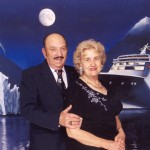 time, because I keep thinking of all the people who wouldn’t be in my life if I was a little girl, a teenager, or even a young mother. Not having my husband, children, or grandchildren would never be my choice, simply for the opportunity to be younger, but would that I could turn back time…maybe just fifteen years to a time when both my parents were healthy, as was my father-in-law, and my kids still lived here…I might consider it…if it were possible. Unfortunately, it isn’t possible, so I must live in the time that I am in, and with the circumstances as they exist now. That is the way life is.
time, because I keep thinking of all the people who wouldn’t be in my life if I was a little girl, a teenager, or even a young mother. Not having my husband, children, or grandchildren would never be my choice, simply for the opportunity to be younger, but would that I could turn back time…maybe just fifteen years to a time when both my parents were healthy, as was my father-in-law, and my kids still lived here…I might consider it…if it were possible. Unfortunately, it isn’t possible, so I must live in the time that I am in, and with the circumstances as they exist now. That is the way life is.
As for Amy and her family, I am thankful that we will travel to see them and they will travel to see us. I am thankful for free long distance, texting, Facetime, Skype, and Facebook, because they make it so much easier to keep in touch. I see how happy they are, and it is hard to wish things were different for them. I have never met anyone who loves the rain more than Amy, so the Seattle area is really perfect for Amy. Having them 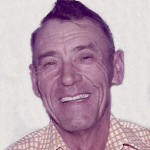 there is just not perfect for me. I guess it would not matter if we were able to zip across the nation as quickly as they could on Star Trek, but we can’t, so I am left feeling lonely and thinking that it would be nice to turn back the hands of time for a little while anyway.
there is just not perfect for me. I guess it would not matter if we were able to zip across the nation as quickly as they could on Star Trek, but we can’t, so I am left feeling lonely and thinking that it would be nice to turn back the hands of time for a little while anyway.
Our lives, nevertheless, are a series of events that once they are played out, there is very little option to go back and change them. We must live them out, following the twists and turns that our journey’s road takes us on, and just doing the best we can to live each moment to the fullest, because even if we would turn back time, we can’t turn back time. Each day once spent is over and can never be spent a second time.
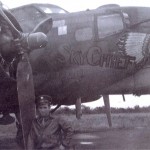 Many times I have written about my Dad’s time in the war, and what he went through, but I’m not sure I truly understood what he went through. Dad never talked about the war much, and maybe that led us to believe that what he went through wasn’t so bad for him. In reality, I don’t think I knew much about Dad’s service time at all. My nephew loaned me a movie called Fortress, and I was very interested in watching it. I don’t know what I expected it to be, but it was not. Everything on the B-17 happened so very fast.
Many times I have written about my Dad’s time in the war, and what he went through, but I’m not sure I truly understood what he went through. Dad never talked about the war much, and maybe that led us to believe that what he went through wasn’t so bad for him. In reality, I don’t think I knew much about Dad’s service time at all. My nephew loaned me a movie called Fortress, and I was very interested in watching it. I don’t know what I expected it to be, but it was not. Everything on the B-17 happened so very fast.
While the movie was quite graphic, and not one that some people would like to watch, it was based on a true story and it gave me a very different perspective about what it was like to fly in a B-17 Bomber. I knew that the life of a ball turret gunner in combat was a mere twenty minutes, and I knew that during the time Dad was on the B-17, there was at least one ball turret gunner who was killed. They tried to save him, but it was not to be. In an instant it was over.

The Flying Fortress, as the B-17 Bomber was called, was one of the safer parts of the war, but that meant nothing when you are flying to a bomb drop and the enemy doesn’t want you to make it. The movie brought home just how hard it was to really spot the enemy planes. They would say that the enemy was right there, and I found myself thinking, “Where?” Then suddenly there they were, and the men on the plane had been firing for several seconds already. It felt like trying to explain how to spot the enemy, and by the time you get the word “well” out, you have already been hit.
While any gunner position was dangerous, I was struck by how exposed the waist gunners were. In case you don’t know, the waist gunners are the guys that shoot out the side doors of the plane. The doors are open, leaving them with very little protection. They had to be on their toes, because the enemy was shooting for their gun, and if they weren’t paying attention, they were shot before they got a second chance to pay attention. That made things really hard, because they also felt a close commraderie with their partner, the other waist 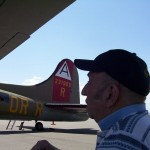 gunner, and if their partner got shot, it was hard to stay on task…but that was hard for any one of the men on the plane.
gunner, and if their partner got shot, it was hard to stay on task…but that was hard for any one of the men on the plane.
Watching the men they worked with every day, get shot and killed became a normal thing. Being normal and being able to cope, are two very different things. These men had to hold it together, while quietly falling apart inside. They knew their friend was dead, and yet they had to do their job. They couldn’t grieve. They couldn’t stop. They had to push that picture of their dead friend way back inside themselves, and do their job. Lives depended on it…including their own. I knew that my dad was on a B-17, but until I watched that movie, I really didn’t understand all of what that meant.
 I don’t know of any family relationship that exists in my family or in Bob’s family, but I have always had an interest in Benjamin Franklin anyway. I have done a lot of hiking in my life, and sometimes, like it or not, bad weather comes in before we were done with our hike. I think anyone who has hiked much knows that one of your worst enemies on a hike…other than mountain lions, bears, or snakes…is lightning. Personally, when I start to hear thunder, I figure it’s time to head for shelter, but when you are four or five miles from your car, in the middle of a bunch of trees, heading for shelter isn’t always an easy task.
I don’t know of any family relationship that exists in my family or in Bob’s family, but I have always had an interest in Benjamin Franklin anyway. I have done a lot of hiking in my life, and sometimes, like it or not, bad weather comes in before we were done with our hike. I think anyone who has hiked much knows that one of your worst enemies on a hike…other than mountain lions, bears, or snakes…is lightning. Personally, when I start to hear thunder, I figure it’s time to head for shelter, but when you are four or five miles from your car, in the middle of a bunch of trees, heading for shelter isn’t always an easy task.
Ben Franklin, on the other hand saw lightning as a challenge to be explored. I think he had to have known the dangers of such an adventure, because he was a scientist after all. That didn’t really matter to him much, or if it did, he did not show it. Ben Franklin became interested in electricity in the mid-1740s. Not much was known about the subject, but he would spend the next decade conducting experiments using electricity. It was Ben who coined terms still in use today. You now them…battery, conductor, and electrician. He also invented the lightning rod, which is now used to protect buildings and ships. All of these things came from his many experiments. Ben Franklin was an amazing man, publisher, and writer, but it is really not in his writings that I find myself intrigued, but rather his electrical experiments. On this day, June 10, 1752, Ben flew his now infamous kite during a thunderstorm to collect a charge in a Leyden jar, when the kite was struck by lightning. He wanted to demonstrate the electrical nature of lightning.
Benjamin Franklin was born January 17, 1706. People might think that Benjamin Franklin was a highly educated man, but in reality, his formal education ended at age ten. Then he went to work for his brother, James as a printer, but after a dispute in 1723, he left Boston and moved to Philadelphia and found work as a printer. He moved to London for a short time and worked there as a printer, and then returned to Philadelphia. He became a successful businessman whose publishing ventures included the Pennsylvania Gazette and Poor Richard’s Almanack, a collection of homespun proverbs advocating hard work and honesty in order to get 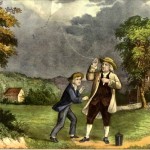 ahead. Eventually, Benjamin Franklin became an overachiever…or at least in the eyes of many people. I think he was just interested in a lot of things.
ahead. Eventually, Benjamin Franklin became an overachiever…or at least in the eyes of many people. I think he was just interested in a lot of things.
Of course, we all know about Benjamin Franklin’s career as a statesman, which spanned for decades, his years as a legislator, and his diplomatic years in England and France. He is the only politician to have signed all four documents fundamental to the creation of the US: the Declaration of Independence (1776), the Treaty of Alliance with France (1778), the Treaty of Paris (1783), which established peace with Great Britain, and the U.S. Constitution (1787). Yes, he was an all around amazing man, but I will always love the idea of his lightning experiments the best.
 Sometimes in life, you find that something is just meant to be. This is a story of just that…something that was meant to be. A while back, my niece Lacey Stevens introduced her brother, Garrett Stevens to a friend of hers, Kayla Smiley. That was the first step in a journey that for Garrett and Kayla would lead to happily ever after. They became engaged in a romantic setting in the Big Horn Mountains, with the involvement of her family, in which Garrett popped the question on the top of a hill while the fmily was taking pictures. Kayla had no idea. Good job Garrett.
Sometimes in life, you find that something is just meant to be. This is a story of just that…something that was meant to be. A while back, my niece Lacey Stevens introduced her brother, Garrett Stevens to a friend of hers, Kayla Smiley. That was the first step in a journey that for Garrett and Kayla would lead to happily ever after. They became engaged in a romantic setting in the Big Horn Mountains, with the involvement of her family, in which Garrett popped the question on the top of a hill while the fmily was taking pictures. Kayla had no idea. Good job Garrett.
For the rest of the family, this relationship has been a bit unusual, in that Kayla lived right next door to our mom’s house. I suppose that many people would feel like that could be a bit awkward, but not Kayla and Garrett. In fact, it was there that Kayla’s true self was shown to all of us. Kayla is a very caring person. She gives of herself easily, and that was exactly what we needed at that time in our lives. During Mom’s last couple of years, there were a times when an ambulance had to be called, because she was having some occasional bronchial issues. That is such a stressful thing for the children, especially when one child, in this case, my sister, Cheryl Masterson had to be there by herself at the time the ambulance needed to be called. Kayla, the instant she heard the ambulance, came right over to see what she could do to help, and if for no other reason, just to be there and be supportive to me sister, my mom, and to me as well. If you have never been in the position of needing to call an ambulance for your parent, you simply can’t know how devastating that feels. You find yourself forced to watch the proceedings, and there is nothing you can do to help. All too often, the emergency workers are so focused on their patient…as it should be, but they have no  time to see you standing there quietly falling apart. Kayla…and Garrett too, while they were as worried as we were, came to support us as we went through this horrible ordeal. That is a kindness that can never be forgotten, much less repaid.
time to see you standing there quietly falling apart. Kayla…and Garrett too, while they were as worried as we were, came to support us as we went through this horrible ordeal. That is a kindness that can never be forgotten, much less repaid.
We knew that Garrett had found a gem of a girl, and so when he called to say they were engaged, it was with much joy that we congratulated them. They are both such sweet, loving people, and I know that their life together will be blessed in so many ways. God will repay their kindness with joy and love for years to come. I am so excited for them. Today is Kayla’s birthday. Kayla we just don’t know what we would do without you in our lives. Happy birthday Kayla!! Have a great day!! We love you!!
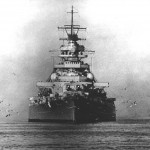 After I wrote the story about the sinking of the Bismarck, my nephew, Steve Spethman told me about a documentary he had about the man who located the Bismarck, and the search for it. Of course, I jumped at the chance to watch it, but when I was done watching it, I felt…different. It’s easy to be excited about a victory in a battle in wartime, or in a war that your dad fought in. It’s easy to set aside the thoughts of lives lost in historic battles, when you know that the battle had to be fought, and the victory would determine the course of the world stage. The problem with that thinking though, is that all too often…especially in countries governed by an evil dictator, such as Adolf Hitler, the people involved in the war, have no choice as to whether or not to fight. I know that a draft is sometimes necessary, but I would much rather have a military machine composed of volunteers than one from a draft. I think volunteers know what they are walking into. It is a cause they agree with, not one they were forced to accept.
After I wrote the story about the sinking of the Bismarck, my nephew, Steve Spethman told me about a documentary he had about the man who located the Bismarck, and the search for it. Of course, I jumped at the chance to watch it, but when I was done watching it, I felt…different. It’s easy to be excited about a victory in a battle in wartime, or in a war that your dad fought in. It’s easy to set aside the thoughts of lives lost in historic battles, when you know that the battle had to be fought, and the victory would determine the course of the world stage. The problem with that thinking though, is that all too often…especially in countries governed by an evil dictator, such as Adolf Hitler, the people involved in the war, have no choice as to whether or not to fight. I know that a draft is sometimes necessary, but I would much rather have a military machine composed of volunteers than one from a draft. I think volunteers know what they are walking into. It is a cause they agree with, not one they were forced to accept.
The movie about the Bismarck’s location, while mostly about the location of a sunken ship, was very different  from the documentaries I had seen about other ships, like the Titanic. While both ships were located by the same man, Robert Ballard, the feelings taken away from the Bismarck, both for Ballard and for the audience were quite different. The addition of commentary from some of the actual survivors of the Bismarck, as well as men on the ships who went in for the final sinking and the rescue of survivors, was very sobering. I was very moved by the German men who remembered the name of the man, Joe Brooks, who risked his own life to try to pull them from the water. They said, in fact, that his name was revered among German soldiers everywhere. This was a man who, in a war situation, chose to do good to his enemies…an almost unheard of act in wartime, but that act from the middle of a war, is still remembered 74 years later.
from the documentaries I had seen about other ships, like the Titanic. While both ships were located by the same man, Robert Ballard, the feelings taken away from the Bismarck, both for Ballard and for the audience were quite different. The addition of commentary from some of the actual survivors of the Bismarck, as well as men on the ships who went in for the final sinking and the rescue of survivors, was very sobering. I was very moved by the German men who remembered the name of the man, Joe Brooks, who risked his own life to try to pull them from the water. They said, in fact, that his name was revered among German soldiers everywhere. This was a man who, in a war situation, chose to do good to his enemies…an almost unheard of act in wartime, but that act from the middle of a war, is still remembered 74 years later.
So seldom, when talking about a war, do you hear about both sides of the war. While you may hear about  their goals and reasons for going to war, you don’t hear about the human factor of each side. I think that was the thing that made me feel so different…almost somber after the movie. One man said that in a sea battle, you usually never see the enemy. He saw men…just briefly as they were running across the deck of the Bismarck. That was it…until they were in the water beside his ship. Then they weren’t soldiers, but real people in dire straits, who were about to lose their lives. In the end, Robert Ballard stood alone at the back of the ship he was on when he found the Bismarck, and I could tell that he felt the same way as I did. The war and the battle had both been a necessary action on the part of the allies, because evil cannot be allowed to prevail, but that simply does not change the fact that these were real lives and real tragic situations.
their goals and reasons for going to war, you don’t hear about the human factor of each side. I think that was the thing that made me feel so different…almost somber after the movie. One man said that in a sea battle, you usually never see the enemy. He saw men…just briefly as they were running across the deck of the Bismarck. That was it…until they were in the water beside his ship. Then they weren’t soldiers, but real people in dire straits, who were about to lose their lives. In the end, Robert Ballard stood alone at the back of the ship he was on when he found the Bismarck, and I could tell that he felt the same way as I did. The war and the battle had both been a necessary action on the part of the allies, because evil cannot be allowed to prevail, but that simply does not change the fact that these were real lives and real tragic situations.
 The other day as I was driving to work, I noticed a bird in flight, and how it had to quickly change direction to avoid the car in front of me. Funny as it seems, a thought came to me that if this bird had lived in a different time in history, it would never have had to watch out for the car. in times past, there may have been a wagon or a horse, but if you go back far enough, people had to walk, and so even if they were running, they could not have gone as fast as the car in front of me that was in all reality going pretty slow, by today’s standards. Even the light poles we all take for granted wouldn’t have existed back then. Now lights and wires seem normal to the birds. They land on them as if they were a tree or a rock…or as if they were put there just for them. Often, we think about what life might have been like if we had lived in a different time in history, but rarely do we think of what the animals might have thought as the times changed.
The other day as I was driving to work, I noticed a bird in flight, and how it had to quickly change direction to avoid the car in front of me. Funny as it seems, a thought came to me that if this bird had lived in a different time in history, it would never have had to watch out for the car. in times past, there may have been a wagon or a horse, but if you go back far enough, people had to walk, and so even if they were running, they could not have gone as fast as the car in front of me that was in all reality going pretty slow, by today’s standards. Even the light poles we all take for granted wouldn’t have existed back then. Now lights and wires seem normal to the birds. They land on them as if they were a tree or a rock…or as if they were put there just for them. Often, we think about what life might have been like if we had lived in a different time in history, but rarely do we think of what the animals might have thought as the times changed.
Consider the horses at the time in history when the car was developed. They would often turn away, rear up, or run in the opposite direction when cars first appeared on the road. Then as time passed, the cars seemed no more strange that the person riding on the horses back or the wagon the horse was harnessed to. They were simply another object that the horse now lives in the same world with. And so it was with the bird. Granted the bird had to swiftly make a course change, but that did not mean the bird feared the car. The two of them were just traveling in a direction that put them in the same space at the same time, much like a car accident would.
Animals even get used to the people who share the same space. Take, for instance, the deer that many people…at least in Wyoming, have in our yards, and while they may not let us walk all the way up to them, they do not get up and run out of our yard in fear, but rather, watch us cautiously. Even the squirrels in my yard don’t necessarily run from us. As Bob and I walked out to our garage this morning to go the breakfast,  a squirrel playing near the garage stopped and looked at us. I talked to it, and still it stood there…not five feet from me. The fear of people had long since let this squirrel, possibly because of the fact that it has lived in this area all of its life, but more likely that my neighbors have long had a habit of feeding the squirrels. I suppose many people would not like the idea of feeding the squirrels, but the ones in our neighborhood don’t seem to damage the trees like the ones in other neighborhoods. Maybe because the neighbors feed them…who knows. Whatever the case may be, I can say that much has changed in the things the animals have seen as time has gone by. Like humans, they have adapted to it…getting used to the changes and seeing them as normal now. Maybe they even think, as I do, “Look how far we have come.”
a squirrel playing near the garage stopped and looked at us. I talked to it, and still it stood there…not five feet from me. The fear of people had long since let this squirrel, possibly because of the fact that it has lived in this area all of its life, but more likely that my neighbors have long had a habit of feeding the squirrels. I suppose many people would not like the idea of feeding the squirrels, but the ones in our neighborhood don’t seem to damage the trees like the ones in other neighborhoods. Maybe because the neighbors feed them…who knows. Whatever the case may be, I can say that much has changed in the things the animals have seen as time has gone by. Like humans, they have adapted to it…getting used to the changes and seeing them as normal now. Maybe they even think, as I do, “Look how far we have come.”
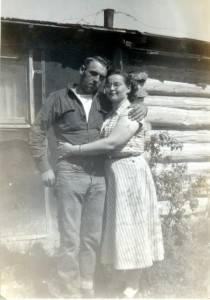 Sixty six years ago, when the bitterly cold winter of 1949 was finally over and spring had finally arrived, my mother-in-law, Joann Knox was a young girl of eighteen, and she was in love. She had known her future husband and the love of her life, Walter Schulenberg, all her life. Still, knowing him didn’t mean they were always in love, or even that they liked each other. Little kids can be friends with someone, and then when they get older, things change. Then, as was the case with my in-laws, things can change again. That annoying teenaged boy or girl suddenly takes on a new look to you. Suddenly, the time is right, and they both wonder why they didn’t see this person this way before. That’s how it was for my in-laws. Grandma Knox, Joann’s mom told me once that after they got older, Mom didn’t like Dad one bit. I would guess that was probably in his bratty adolescent years, when most boys are awkward around girls…especially if they like them at all.
Sixty six years ago, when the bitterly cold winter of 1949 was finally over and spring had finally arrived, my mother-in-law, Joann Knox was a young girl of eighteen, and she was in love. She had known her future husband and the love of her life, Walter Schulenberg, all her life. Still, knowing him didn’t mean they were always in love, or even that they liked each other. Little kids can be friends with someone, and then when they get older, things change. Then, as was the case with my in-laws, things can change again. That annoying teenaged boy or girl suddenly takes on a new look to you. Suddenly, the time is right, and they both wonder why they didn’t see this person this way before. That’s how it was for my in-laws. Grandma Knox, Joann’s mom told me once that after they got older, Mom didn’t like Dad one bit. I would guess that was probably in his bratty adolescent years, when most boys are awkward around girls…especially if they like them at all.
As the years went by, Walt and Joann moved in different circles, and didn’t really see each other very much, but then one day, he noticed her again. My mother-in-law wasn’t too sure how she felt about his new found interest in her, as she still thought of him as a bit of an annoying boy, but if you knew my father-in-law at all, you would know that he had a winning personality, and it was really hard not to like him. That is what my mother-in-law found too. Before long, they were an item. First meeting them after many years of marriage, and meeting them is a more reserved situation…for my mother-in-law at least, I never saw the love struck side of their early relationship. I don’t think their kids really did either. Their love letters, written during the times he was working one place and she another, were tender and sweet. It was such a surprise to see those letters, because they just never seemed to me to be the googly eyed kind of couple, and yet, here in their letters, they were.
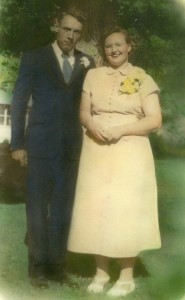
As time passed, their future plans began to grow, and when Joann graduated, they decided to be married. Like their granddaughter, Corrie Petersen, my daughter, they didn’t wait very long after graduation. The wedding took place on the 5th anniversary of D-Day, a fact that I seriously doubt that either of them gave a single thought to…at least not that year. Like many marriages of that time, it was a simple wedding…much like my own parents’ wedding just a few years later. My mother-in-law wore a simple peach colored dress and my father-in-law a suit. Nevertheless, it was for them the perfect day…the culmination of the many years of an on again, off again friendship, now turned to a forever kind of love. Today marks the 66th anniversary of that wedding day, and while my father-in-law has been gone now for two years, my mother-in-law is still alive, and since she does not realize that he is gone, we will still tell her happy anniversary…at the same time that we tell her that Dad is out in the garage working on a car, or at Walmart, or visiting the neighbors, because to tell her he is gone would be just too mean. Happy anniversary to my in-laws, Walt…in Heaven, and Joann, here on Earth. Have a wonderful day. We love you both very much.

